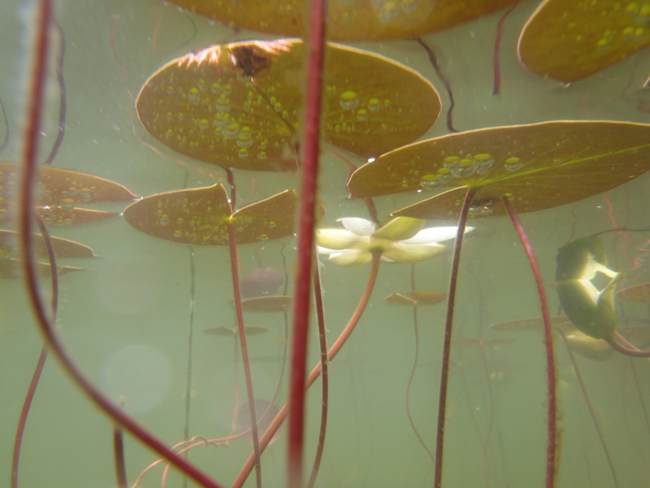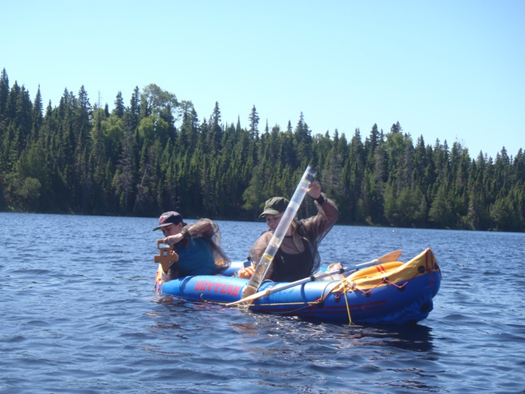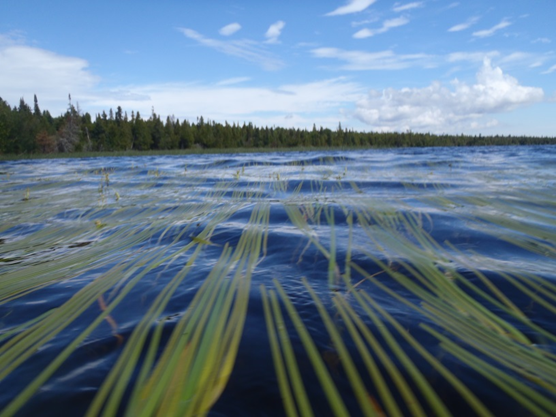
photo by Angela DePalma-Dow
The relative roles of dispersal and establishment for shaping aquatic macrophyte diversity and community structure among the inland lakes of Isle Royale National Park, Michigan, USA.
Angela DePalma-Dow, MS
Department of Fisheries and Wildlife, Michigan State University
East Lansing, MI 48823
Contact: Adepalmadow@gmail.com 530-304-1809
Website: http://www.ksc.fw.msu.edu/student_depalma-dow.htm
Adviser: Dr. Kendra S. Cheruvelil
Funding: Institute of Water Resources (IWR) at Michigan State University, MSU College of Agriculture and Natural Resources Alumni Association, MSU Department of Fisheries and Wildlife, MSU Evolution, Ecology, Behavior, and Biology Program.
Research Rational
For my masters research I studied the aquatic plant (herein referred to as macrophytes) diversity of the inland lakes on Isle Royale National Park. While a large body of research exists for macrophyte studies in urban or heavy-use and recreation lakes, there is limited research being conducted in relatively pristine and undisturbed lakes such as those found on Isle Royale. Isle Royale is unique in that the inland lakes are, for the most part, unaltered by man in their hydrology, surrounding land use, and their connected input/outputs meaning that the biological communities in these lakes provide a wonderful opportunity to study natural conditions. These undisturbed lakes are essential to the development of our knowledge for how lakes function because the data we collect from lakes such as these build the baseline that will be used to effectively gage changes over time.
Aquatic plants are important to lake communities.
In general, macrophytes are very important for lake ecosystem form and function. Macrophytes consume C02 and produce oxygen, they recycle nutrients, stabilize sediments and shorelines, and provide valuable food and shelter for lake-dwelling organisms like fish, insects and even beavers! Not every lake is the same in the type and amount of macrophyte species that make up the community. For my research, I wanted to explore why some aquatic plant species are present, absent, found in abundance or rarity in some lakes and not in others. Answers to this question can help park managers and ecologists monitor changes in lake communities, such as during the introduction of an invasive species or dramatic climate shifts.

photo by Angela DePalma-Dow
Over the summer of 2012-2013 my small field crew and I sampled 15 lakes on the park. We sampled Ahmik, Angleworm, Beaver, Benson, Chickenbone, DeSor, Feldtman, LeSage, Livermore, Mason, McDonald, Ojibway, Otter, Patterson, and Richie lakes. At each lake we sampled a suite of common physical and chemical metrics like water and sediment samples for Nitrogen and Phosphorous, Alkalinity, Water Color, water transparency (clarity), lake size, maximum depth, and lake shape (SDF). I also inventoried the macrophytes found in each lake; I recorded the number of species found (Richness), the diversity of the macrophyte community in each lake (number and relative amount of each species). I also characterized the growth type of macrophytes in each lake by grouping plants as submersed (living entirely under water), floating leaf (think of a traditional lily pad) and emergent (like the shoreline grasses that are rooted in the water).

photo by Angela DePalma-Dow
Here are some summary notes from the results portion of my research. We found so many interesting things, but here are just a few of the most important!
- MacDonald Lake had the highest richness (number of species) found among all sampled lakes and Ojibway had the least.
- Regarding diversity (number and amount of each species found) ,Chickenbone Lake contained the most diverse macrophyte community (Using Shannon Evenness and Inverse Simpson metrics). Feldtman Lake was the least diverse.
- For the growth type, the majority of macrophytes found in all lakes sampled were submersed species.
- Alkalinity and sediment phosphorous were the two environmental variables that had the most influence on richness, diversity and growth type of aquatic macrophytes in all sampled lakes.
- Alkalinity is important for determining pH of water in lakes. The higher the alkalinity of the water, the higher the ability of that lake water to resist changes in pH. Changes in pH can occur from stream inputs, landscape runoff, atmospheric nitrogen deposition, and even rain can be slightly acidic and affect the pH of a lake after a large rain event.
- Phosphorous is a needed nutrient for plants; it contributes to overall physical structure and flowering components in plants. Phosphorous is mostly found in sediments as it attached readily to soil particles, therefore it makes sense that phosphorous levels in the sediment would relate to the diversity of macrophytes species found in these lakes.
- Water color was secondly the most important variable for influencing macrophytes in sampled lakes. Water color is different from water transparency (clarity) in that it characterizes the Dissolved Organic Matter (DOC) within a water column in addition to the ability of light to penetrate that water column. Because plants rely on light to conduct photosynthesis, the amount and color of light getting to the plants is important in determining what species can grow.
- These results provide reference information about Isle Royale lake communities that can be used to monitor natural variation of these plant communities as well as when identifying and understanding future community responses to pressures such as climate change and invasive species introductions.
Last updated: September 13, 2017
